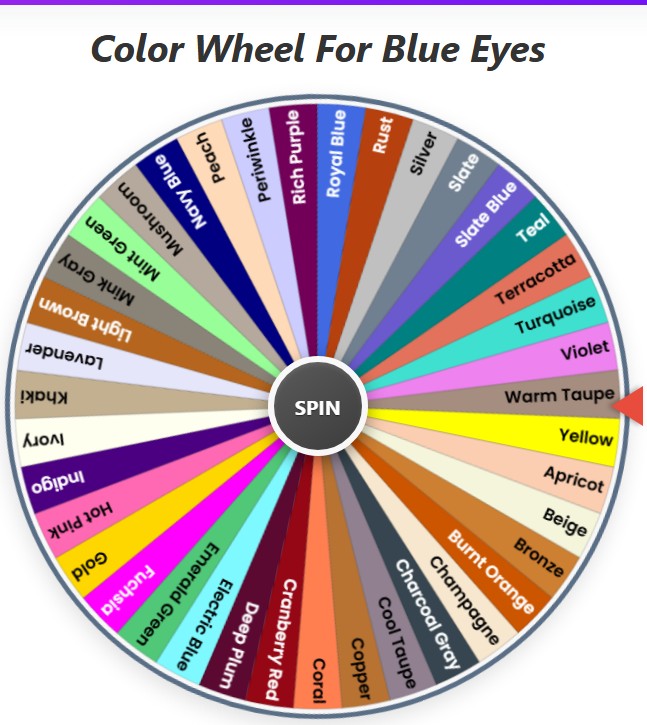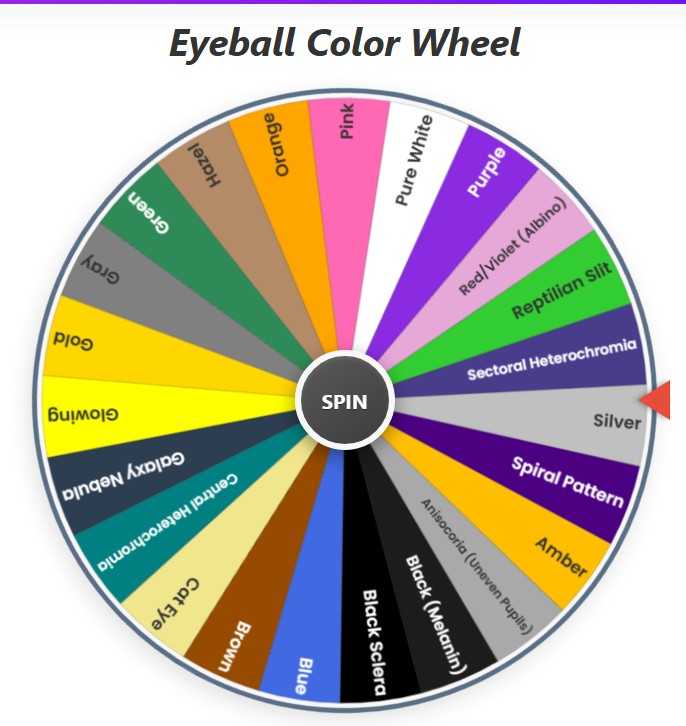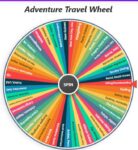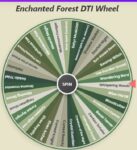Eye Color Wheel
Current Mode: None
Quick link:
- Random Letter Generator - wheel from A to Z
- Yes or no wheel
- Random Number Generator Wheel
- 0 to never spinner wheel
- Zodiac Sign Wheel
- Rainbow Wheel Spin
- Random Football Teams Generator Wheel
The Ultimate Eye Color Wheel: Your Fun Random Eye Color Generator
Ever been stuck trying to imagine the perfect eye color for a character in your story? Or maybe you're an artist sketching a portrait and need a spark of inspiration? Welcome to the ultimate eye color wheel, a fun and incredibly useful tool designed to give you a random eye color with a simple spin.
Think of it as your personal random eye color generator, ready to help you break through creative blocks or just satisfy your curiosity.
This guide will walk you through everything our eye color wheel spinner can do. We'll explore its powerful controls, versatile features, and the curated color categories that make it more than just a simple randomizer. Let’s get spinning! 🎡
Explore All the Eye Colors
Before we dive into the controls, let's see the beautiful spectrum of colors waiting for you on the wheel. The tool is pre-loaded with several categories, each containing a specific set of hues.
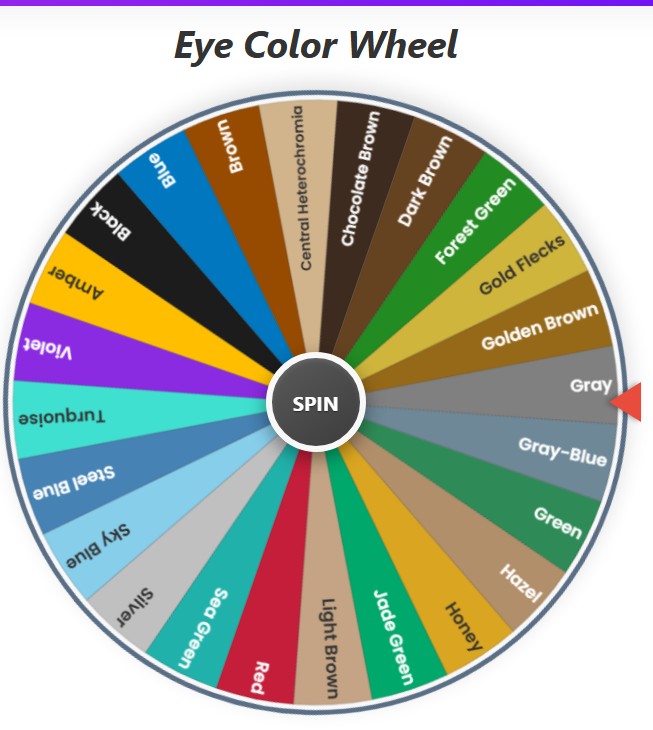
Common Colors
- Brown
- Blue
- Hazel
- Green
- Gray
- Amber
Shades of Brown
- Light Brown
- Dark Brown
- Chocolate Brown
- Honey
- Golden Brown
Shades of Blue & Green
- Sky Blue
- Steel Blue
- Sea Green
- Forest Green
- Turquoise
- Jade Green
- Gray-Blue
Rare & Unusual Colors
- Violet
- Silver
- Red
- Black
- Gold Flecks
- Central Heterochromia
How Does the Eye Color Wheel Work?
At its core, the eye colour wheel is a digital spinning wheel. Each slice of the wheel represents a different eye color. When you hit the "SPIN" button, the wheel whirls into motion, creating a delightful sense of anticipation. After a few seconds, it slows down and the pointer lands on one specific slice, revealing your randomly selected eye color.
What makes this tool special is its realism and attention to detail. The color of each slice visually matches the name written on it. A "Sky Blue" slice is actually a lovely sky-blue color, and "Forest Green" is a deep, rich green. This visual connection makes the experience much more immersive and helpful, especially for visual creators.
Getting Started: Your First Spin
Using the eye color randomizer is as easy as pie. When you first load the page, you'll see the vibrant, multi-colored wheel. The default category, "All Colors," is active, meaning every single predefined eye color is on the wheel.
In the very center of the wheel is a large, inviting "SPIN" button. Go on, give it a click! You'll hear a satisfying spinning sound as the wheel accelerates.
A few moments later, it will come to a halt, and a pop-up window will announce the winner. Confetti will even burst on the screen to celebrate your result! 🎉 It’s that simple. But the fun doesn't stop there; this tool has a whole suite of features to explore.
Master the Controls
To the right of the wheel, you'll find the control panel. This is your command center for customizing the wheel to your exact needs. Let's break down each function.
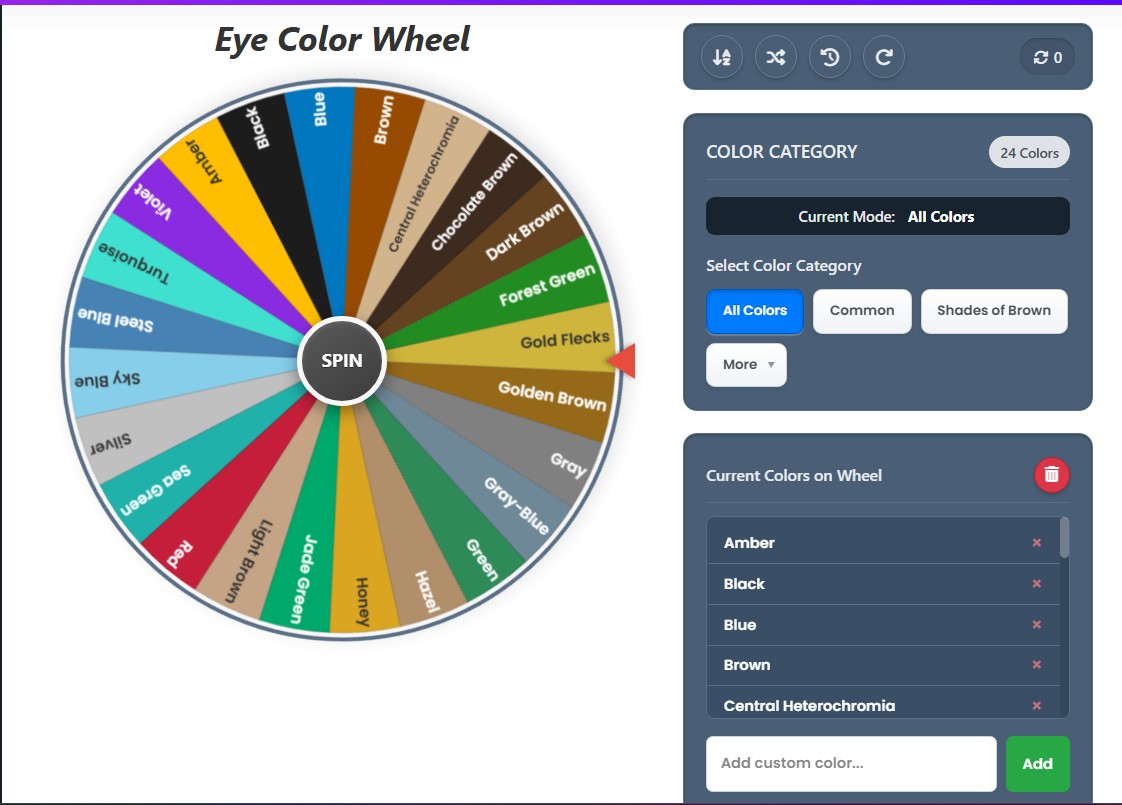
The Action Buttons: Your Command Center
At the top of the control panel is a sleek bar with several circular buttons. These are your one-click tools for managing the list of colors on the wheel.
- Sort A-Z: Feeling organized? Click this button to instantly sort all the colors currently on the wheel in alphabetical order. This is great for when you have a custom list and want to find a specific color easily.
- Shuffle: Want to mix things up? The shuffle button will randomize the order of the colors on the wheel. This doesn't change what colors are on the wheel, just their position. It adds an extra layer of randomness to the visual experience.
- History: Curious about your past spins? This button opens a pop-up window that shows a numbered list of your most recent results. It's a fantastic feature for writers or artists who want to review the last few colors they generated without having to write them down. You can also clear your history from this window.
- Reset All: If you've made a lot of custom changes and want to go back to the beginning, this is your button. It resets the wheel to its original state, activating the "All Colors" category and clearing your spin count and history. It's a fresh start!
The Spin Counter: Keep Track
To the far right of the action buttons, you’ll see a small counter with a sync icon. This handy little display keeps track of how many times you've spun the wheel in your current session. It’s a simple but satisfying way to see how much you've used the tool.
Dive into Color Categories
The true power of this eye color generator lies in its categories. Instead of always spinning with every possible color, you can narrow down your options to fit a specific theme or requirement. This is perfect for character creation when you already have a general idea of the eye color you want.
H3: All Colors: The Full Spectrum
This is the default mode. It loads every single built-in color onto the wheel, giving you the widest possible range of outcomes. It’s perfect for when you have no preconceived notions and want the eye color wheel spinner to surprise you completely.
H3: Common Colors: The Everyday Hues
This category narrows the wheel down to the most frequently seen eye colors in the real world. If you're creating characters for a realistic story, this is the perfect category to use. It includes:
- Brown, Blue, Hazel, Green, Gray, Amber
H3: Shades of Brown: Warm and Earthy
Brown eyes are beautiful and incredibly diverse. This category is dedicated to exploring their rich and warm spectrum. It's perfect for when you know you want a character with brown eyes but need help deciding on the specific shade. The options include:
- Light Brown, Dark Brown, Chocolate Brown, Honey, Golden Brown
H3: Shades of Blue & Green: Cool and Captivating
Blue and green eyes are often associated with striking and memorable characters. This category groups together their various shades, from the light and airy to the deep and mysterious. It’s ideal for fantasy or romance genres where eye color can play a significant role. This category features:
- Sky Blue, Steel Blue, Sea Green, Forest Green, Turquoise, Jade Green, Gray-Blue
H3: Rare & Unusual Colors: The Striking and Mystical
Ready to create a truly unique character? This category is loaded with the most uncommon and fantastical eye colors. It includes naturally rare colors as well as some that are pure fantasy, perfect for supernatural beings, aliens, or magical characters. The choices are:
- Violet, Silver, Red, Black, Gold Flecks, Central Heterochromia
The List Box: Your Personal Palette
Below the category selector is one of the tool's most powerful features: the item list box. This box shows you every single color that is currently on the wheel. But it’s not just a display—it’s fully interactive! This is where the tool transforms from a simple spinner into a fully customizable eye colour wheel.
Adding Your Own Colors
At the bottom of the list box, there's a text field that says, "Add custom color..." Here, you can type in any color you can imagine! Maybe "Electric Blue" or "Sunset Orange"? Type it in, click the "Add" button, and it will instantly appear on both the list and the wheel. Note that custom colors you add will appear as a neutral gray slice, as the tool only has pre-mapped colors for its default entries.
Editing and Removing Colors
Don't like an entry? You can change it! Simply click on any color name in the list, and you can edit the text directly. Hit Enter or click away to save your change.
Want to remove a color? To the right of each name is a small '×' button. Click it, and that color will be removed from the wheel. This is a great way to refine your list. For example, you could start with the "Common Colors" category and then remove "Gray" and "Amber" to only spin between the other four.
Clearing the Wheel
If you want to start your custom list from scratch, look for the trash can icon in the header of the list box. Clicking this will wipe all the current colors from the wheel, giving you a blank canvas to build your very own, personalized eye color randomizer.
After the Spin: What's Next?
The experience doesn't end when the wheel stops. The result pop-up gives you powerful options to continue your creative journey.
The Result Modal: Your Winner!
The modal clearly displays your winning color. From here, you have a few choices:
- OK: If you're happy with the result and just want to close the window, click "OK."
- Spin Again: If you want to keep the same list of colors and immediately try your luck again, this button closes the modal and starts a new spin right away.
Eliminate and Spin Again
This is a fan-favorite feature! The "Eliminate Result" button removes the winning color from the wheel and then closes the pop-up. This is perfect for "process of elimination" scenarios. For example, if you're generating eye colors for a family of five characters, you can spin, get a color, assign it to a character, and then eliminate it to ensure you don't get the same color twice.
Who is this Tool For?
This versatile eye color wheel is for anyone who needs a dash of chromatic inspiration.
For Writers and Storytellers ✍️
Struggling with character descriptions? A quick spin can give you a unique eye color that might even influence a character's personality. Is your protagonist a warm, "Honey" eyed hero or a mysterious, "Steel Blue" eyed villain?
For Artists and Designers 🎨
Whether you're painting, drawing, or creating digital art, this tool can help you break out of your color habits. The visual representation of colors on the wheel provides an instant reference point for your palette.
For Role-Players and Gamers 🎲
Creating a new character for Dungeons & Dragons or another RPG? The eye color generator can add a fun, random element to your character creation process. The "Rare & Unusual" category is especially perfect for fantasy settings.
For Simple Fun and Curiosity 🤔
You don't need a big project to use the wheel. Sometimes, it's just fun to spin and see what you get. Challenge a friend to see who can get the rarest color, or just spin it when you're bored. It’s a simple, joyful, and engaging experience for everyone.
So go ahead, give the eye color wheel a spin, and let a world of color inspire you


